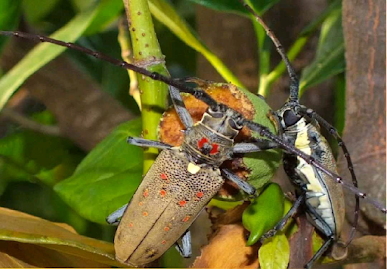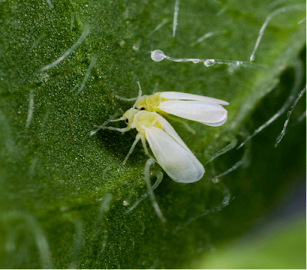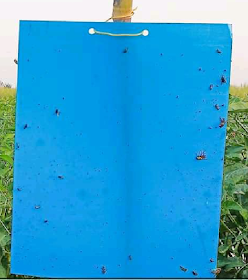1. Mango stem borer
- Scientific Name: Batocera rubus
- Oviposition Site: Cavities of the trunk
- Pupation Site: inside affected trunk
- Damaging Stage: Grub and Adult
- Nature of Damage: Grub make zig-zag burrow in bark, tunnel in the bark
- Management: probe method, extract grub with hooked iron method
2. Mango nut weevil
- Damaging Stage: Grub and adult
- Nature of Damage: Grub enter into fruit discolour the pulp
- Management: Spray the kerosene oil, Digging of Soil, Destruction of infected fruit
3. Tea mosquito bug
- Scientific Name: Helopeltis antonii
- Oviposition Site: fruit
- Pupation Site: Pupation occurs on the tea bushes
- Damaging Stage: nymph & adult
- Nature of Damage: Sucks Sap from Leaves
- Management: Wettable Sulphur @ 20kg/ha
4. Red palm weevil
- Oviposition Site: base of leaf sheath.
- Pupation Site: cocoons
- Damaging Stage: Grub
- Nature of Damage: Grubs bore into trunk, feed on soft tissue
- Management: monocrotophos @ 20 ml/palm.
5. Fruit fly
- Scientific Name: Dacus dorsalis
- Oviposition Site: fruit
- Pupation Site: soil
- Damaging Stage: maggots
- Nature of Damage: maggots feed on pulp
- Management: Trapping using fruit fly traps, bait sprays, fruit bagging, male annihilation techniques, insecticide application
6. Banana Rootstock
- Scientific Name: Cosmopolites sordidus
- Oviposition Site: Grub and adult
- Pupation Site: The larvae pupate in the soil.
- Damaging Stage: The larvae feed on the roots, causing damage to the root system.
- Nature of Damage: Bore into stem a feed inside
- Management: Cultural practices such as proper sanitation, avoiding planting in infested areas, and Removal of Pseudostem
7. White Grub
- Scientific Name: Holotricha Spp.
- Oviposition Site: Adult beetles lay eggs in the soil.
- Pupation Site: Larvae pupate in the soil.
- Damaging Stage: Grub and adult
- Nature of Damage: White grub infestation can lead to reduced plant growth, wilting, and yellowing of plant, even plant death in severe cases.
- Management: Spraying of Chlorpyriphos 50% EC
8. Rhinoceros Beetle
- Scientific Name: Oryctes rhinoceros
- Oviposition Site: Adult beetles lay eggs in decaying organic matter, such as compost piles or dead trees.
- Pupation Site: Larvae pupate in the soil or in decaying matter.
- Damaging Stage: Grub and adult
- Nature of Damage: Damage tender plant parts
- Management: Removing decaying organic matter, Aggregation Pheromone- rhinolure, probe method
9. Diamondback Moth
- Scientific Name: Plutella xylostella
- Oviposition Site: Female moths lay eggs on the undersides of leaves.
- Pupation Site: leaves.
- Damaging Stage: The larvae (caterpillars) are the damaging stage as they feed on leaves.
- Nature of Damage: feed on epidermis of leaves
- Management: Integrated pest management (IPM) practices, malathion and Hand Picking
10. Onion Thrips
- Scientific Name: Thrips tabaci
- Oviposition Site: Female thrips insert eggs into the leaves of onion plants.
- Pupation Site: The larvae drop to the ground to pupate in the soil.
- Damaging Stage: Nymph & Adult
- Nature of Damage: Onion thrips damage onion plants by sucking sap from leaves, causing silvery streaks or blotches, stunted growth, and deformed bulbs.
- Management: Use of Blue Sticky traps, fipronil 5% SC
11. Termite
12. Brinjal Shoot and Fruit Borer
13. Red Spider Mite
14. Tomato Fruit Borer
15. Root Knot Nematode
16. Potato Cyst Nematode
17. Whitefly
18. Yellow Sticky Trap
19. Blue Sticky Trap
If you have Telegram, you can view and join
Knowledge Escalation right away






















